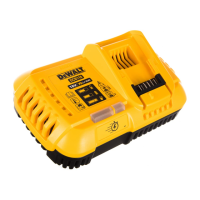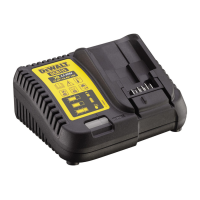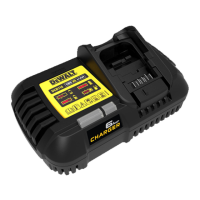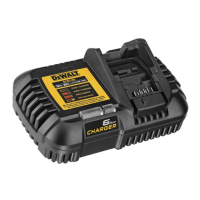8
ENGLISH
READ ALL INSTRUCTIONS
• Do not charge or use battery in explosive atmospheres, such as in the presence of
flammable liquids, gases or dust. Inserting or removing the battery from the charger
may ignite the dust orfumes.
• Never force battery pack into charger. Do not modify battery pack in any way to
fit into a non‑compatible charger as battery pack may rupture causing serious
personalinjury.
• Charge the battery packs only in DeWALTchargers.
• DO NOT splash or immerse in water or otherliquids.
• Do not store or use the tool and battery pack in locations where the temperature
may fall below 4˚C (34˚F) (such as outside sheds or metal buildings in winter),
or reach or exceed 40˚C (104˚F) (such as outside sheds or metal buildings
insummer).
• Do not incinerate the battery pack even if it is severely damaged or is completely
worn out. The battery pack can explode in a fire. Toxic fumes and materials are created
when lithium‑ion battery packs areburned.
• If battery contents come into contact with the skin, immediately wash area with
mild soap and water. If battery liquid gets into the eye, rinse water over the open eye for
15minutes or until irritation ceases. If medical attention is needed, the battery electrolyte is
composed of a mixture of liquid organic carbonates and lithiumsalts.
• Contents of opened battery cells may cause respiratory irritation. Provide fresh air. If
symptoms persists, seek medicalattention.
WARNING: Burn hazard. Battery liquid may be flammable if exposed to spark orflame.
WARNING: Never attempt to open the battery pack for any reason. If battery pack
case is cracked or damaged, do not insert into charger. Do not crush, drop or damage
battery pack. Do not use a battery pack or charger that has received a sharp blow, been
dropped, run over or damaged in any way (i.e., pierced with a nail, hit with a hammer,
stepped on). Electric shock or electrocution may result. Damaged battery packs should
be returned to service centre forrecycling.
WARNING: Fire hazard. Do not store or carry the battery pack so that metal
objects can contact exposed battery terminals. For example, do not place the
battery pack in aprons, pockets, tool boxes, product kit boxes, drawers, etc., with loose
nails, screws, keys,etc.
CAUTION: When not in use, place tool on its side on a stable surface where it
will not cause a tripping or falling hazard. Some tools with large battery packs will
stand upright on the battery pack but may be easily knockedover.

